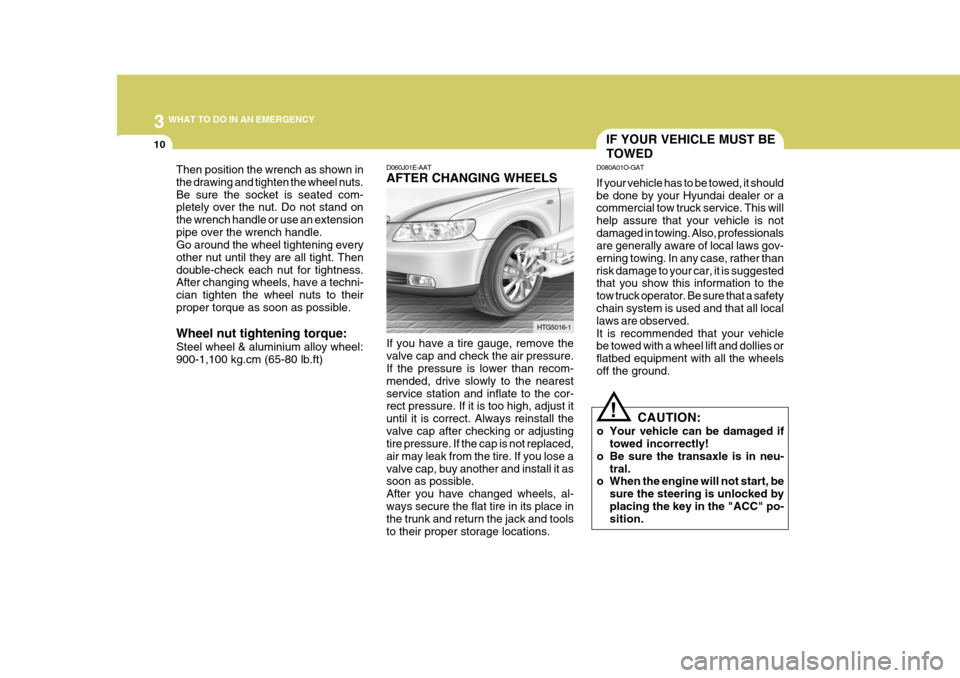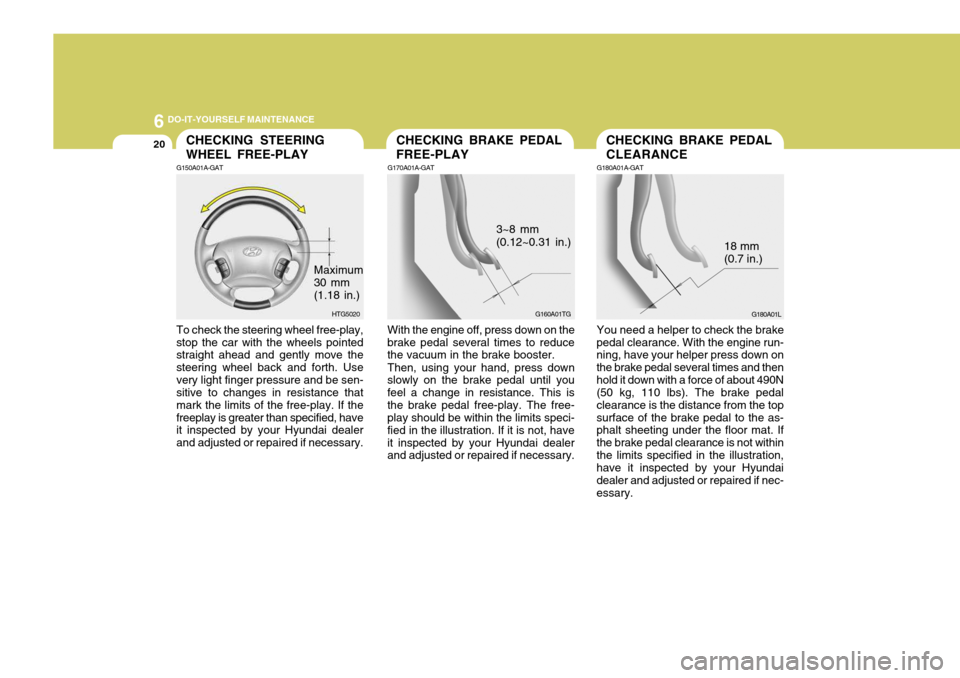Page 217 of 297

3 WHAT TO DO IN AN EMERGENCY
10
Then position the wrench as shown in the drawing and tighten the wheel nuts.Be sure the socket is seated com- pletely over the nut. Do not stand on the wrench handle or use an extensionpipe over the wrench handle. Go around the wheel tightening every other nut until they are all tight. Thendouble-check each nut for tightness. After changing wheels, have a techni- cian tighten the wheel nuts to theirproper torque as soon as possible. Wheel nut tightening torque: Steel wheel & aluminium alloy wheel: 900-1,100 kg.cm (65-80 lb.ft) D060J01E-AAT AFTER CHANGING WHEELS If you have a tire gauge, remove the valve cap and check the air pressure. If the pressure is lower than recom- mended, drive slowly to the nearestservice station and inflate to the cor- rect pressure. If it is too high, adjust it until it is correct. Always reinstall thevalve cap after checking or adjusting tire pressure. If the cap is not replaced, air may leak from the tire. If you lose avalve cap, buy another and install it as soon as possible. After you have changed wheels, al-ways secure the flat tire in its place in the trunk and return the jack and tools to their proper storage locations.HTG5016-1
IF YOUR VEHICLE MUST BE TOWED
D080A01O-GAT If your vehicle has to be towed, it should be done by your Hyundai dealer or a commercial tow truck service. This will help assure that your vehicle is notdamaged in towing. Also, professionals are generally aware of local laws gov- erning towing. In any case, rather thanrisk damage to your car, it is suggested that you show this information to the tow truck operator. Be sure that a safetychain system is used and that all local laws are observed. It is recommended that your vehicle be towed with a wheel lift and dollies or flatbed equipment with all the wheelsoff the ground.
! CAUTION:
o Your vehicle can be damaged if towed incorrectly!
o Be sure the transaxle is in neu- tral.
o When the engine will not start, be
sure the steering is unlocked by placing the key in the "ACC" po- sition.
Page 256 of 297

6 DO-IT-YOURSELF MAINTENANCE
20
G180A01L
18 mm (0.7 in.)
You need a helper to check the brake
pedal clearance. With the engine run- ning, have your helper press down on the brake pedal several times and thenhold it down with a force of about 490N (50 kg, 110 lbs). The brake pedal clearance is the distance from the topsurface of the brake pedal to the as- phalt sheeting under the floor mat. If the brake pedal clearance is not withinthe limits specified in the illustration, have it inspected by your Hyundai dealer and adjusted or repaired if nec-essary.
With the engine off, press down on the
brake pedal several times to reduce the vacuum in the brake booster.
Then, using your hand, press down
slowly on the brake pedal until you feel a change in resistance. This isthe brake pedal free-play. The free- play should be within the limits speci- fied in the illustration. If it is not, haveit inspected by your Hyundai dealer and adjusted or repaired if necessary. G160A01TG
3~8 mm (0.12~0.31 in.)To check the steering wheel free-play, stop the car with the wheels pointed straight ahead and gently move the steering wheel back and forth. Usevery light finger pressure and be sen- sitive to changes in resistance that mark the limits of the free-play. If thefreeplay is greater than specified, have it inspected by your Hyundai dealer and adjusted or repaired if necessary. HTG5020
Maximum 30 mm (1.18 in.)
CHECKING STEERING WHEEL FREE-PLAY
G150A01A-GATCHECKING BRAKE PEDAL FREE-PLAY
G170A01A-GATCHECKING BRAKE PEDAL CLEARANCE
G180A01A-GAT
Page 286 of 297

8
CONSUMER INFORMATION
5
!WARNING:
Do not mix bias-ply and radial-ply
tires under any circumstances. This may cause dangerous handling characteristics that may cause death, serious injury, or propertydamage. I070A01A-AAT TIRE BALANCING A tire that is out of balance may affect handling and tire wear. The tires on your Hyundai were balanced before the car was delivered but may needbalancing again during the years you own the car. Whenever a tire is dismounted for repair, it should be rebalanced before being reinstalled on the car. I080A01A-AAT TIRE TRACTION Tire traction can be reduced if you drive on worn tires, tires that are improperly inflated or on slippery road surfaces. Tires should be replacedwhen tread wear indicators appear. To reduce the possibility of losing control, slow down whenever there israin, snow or ice on the road.
I090A01Y-GAT WHEN TO REPLACE TIRES The original tires on your car have tread wear indicators. The tread wear indicators appear when the treaddepth is 1.6 mm (0.06 in.). The tire should be replaced when these ap- pear as a solid bar across two ormore grooves of the tread. Always replace your tires with those of the recommended size. If you changewheels, the new wheel's rim width and offset must meet Hyundai speci- fications.HTG5016
Tread wear indicator
1.6 mm (0.06 in.)